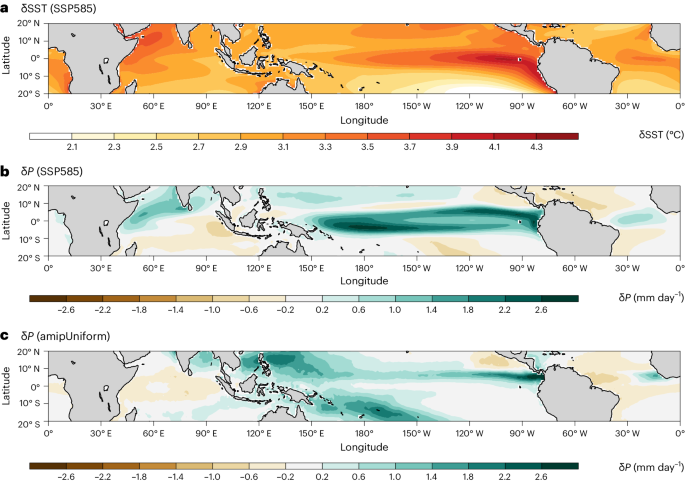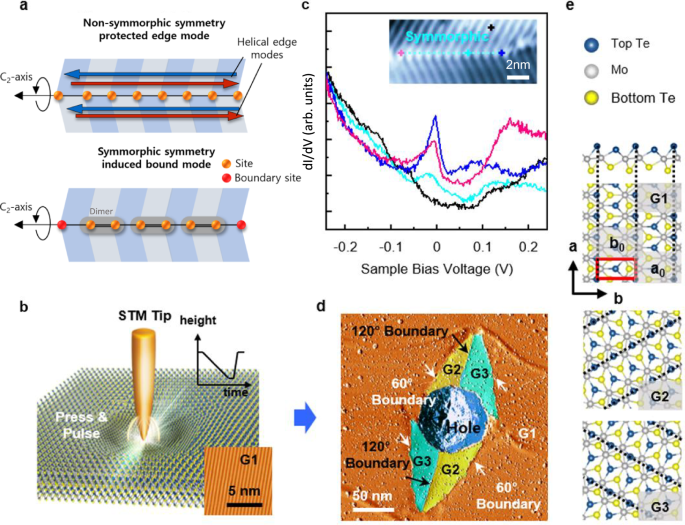
- Select a language for the TTS:
- UK English Female
- UK English Male
- US English Female
- US English Male
- Australian Female
- Australian Male
- Language selected: (auto detect) - EN
Play all audios:
ABSTRACT The three tropical basins each have unique roles in the global climate system. The main mechanism by which tropical oceans affect remote climate is the latent heating of local
precipitation. Here we report major differences in hydrological sensitivity (precipitation change per unit surface warming) among tropical basins. Specifically, the Pacific hydrological
sensitivity is several times as large as that of the Indian basin, while the Atlantic hydrological sensitivity is negative. This results from a thermodynamic amplification of the existing
spatial unevenness in relative humidity, with the wettest basin getting wetter and the driest basin getting drier. The diverging basin hydrological sensitivity is accompanied by an
interbasin repartitioning of latent heating and convective mass fluxes, with far-reaching implications on rainfall and surface temperature over tropical and mid-latitude lands. These results
indicate that the previously unrecognized interbasin differences in hydrological sensitivity may contribute substantially to the geographic pattern of anthropogenic climate change. Access
through your institution Buy or subscribe This is a preview of subscription content, access via your institution ACCESS OPTIONS Access through your institution Access Nature and 54 other
Nature Portfolio journals Get Nature+, our best-value online-access subscription $29.99 / 30 days cancel any time Learn more Subscribe to this journal Receive 12 print issues and online
access $209.00 per year only $17.42 per issue Learn more Buy this article * Purchase on SpringerLink * Instant access to full article PDF Buy now Prices may be subject to local taxes which
are calculated during checkout ADDITIONAL ACCESS OPTIONS: * Log in * Learn about institutional subscriptions * Read our FAQs * Contact customer support SIMILAR CONTENT BEING VIEWED BY OTHERS
HIGHER PRECIPITATION IN EAST ASIA AND WESTERN UNITED STATES EXPECTED WITH FUTURE SOUTHERN OCEAN WARMING Article Open access 02 April 2025 THE GREATER ROLE OF SOUTHERN OCEAN WARMING COMPARED
TO ARCTIC OCEAN WARMING IN SHIFTING FUTURE TROPICAL RAINFALL PATTERNS Article Open access 01 April 2025 HIGH SENSITIVITY OF TROPICAL PRECIPITATION TO LOCAL SEA SURFACE TEMPERATURE Article
26 October 2020 DATA AVAILABILITY Model output and observation data can be accessed at the following websites: CMIP6, https://esgf-node.llnl.gov/projects/cmip6/; observed SST,
https://pcmdi.llnl.gov/mips/amip/; GPCP, https://psl.noaa.gov/data/gridded/data.gpcp.html; CMAP, https://www.psl.noaa.gov//data/gridded/data.cmap.html; TRMM,
https://disc.gsfc.nasa.gov/datasets/TRMM_3B43_7/summary; ERA5, https://cds.climate.copernicus.eu/cdsapp#!/home; NCEP/DOE-II, https://psl.noaa.gov/data/gridded/data.ncep.reanalysis2.html;
JRA-55, https://jra.kishou.go.jp/JRA-55/index_en.html. CODE AVAILABILITY The CESM model code is publicly available at https://www2.cesm.ucar.edu/models/cesm1.2/. Scripts for the analysis and
generation of figures are stored at the _Zenodo_ online repository https://zenodo.org/records/10729735 (ref. 41). REFERENCES * Trenberth, K. E. et al. Progress during TOGA in understanding
and modeling global teleconnections associated with tropical sea surface temperatures. _J. Geophys. Res._ 103, 14291–14324 (1998). Article Google Scholar * Barsugli, J. J. &
Sardeshmukh, P. D. Global atmospheric sensitivity to tropical SST anomalies throughout the Indo-Pacific basin. _J. Clim._ 15, 3427–3442 (2002). Article Google Scholar * Zhang, S., Stier,
P., Dagan, G., Zhou, C. & Wang, M. Sea surface warming patterns drive hydrological sensitivity uncertainties. _Nat. Clim. Change_ 1472, 21–48 (2023). Google Scholar * Allan, R. P.,
Soden, B. J., John, V. O., Ingram, W. & Good, P. Current changes in tropical precipitation. _Environ. Res. Lett._ 5, 025205 (2010). Article Google Scholar * Tan, J., Jakob, C., Rossow,
W. B. & Tselioudis, G. Increases in tropical rainfall driven by changes in frequency of organized deep convection. _Nature_ 519, 451–454 (2015). Article CAS Google Scholar * Xie,
S.-P. et al. Global warming pattern formation: sea surface temperature and rainfall. _J. Clim._ 23, 966–986 (2010). Article Google Scholar * Duffy, M. L., O’Gorman, P. A. & Back, L. E.
Importance of Laplacian of low-level warming for the response of precipitation to climate change over tropical oceans. _J. Clim._ 33, 4403–4417 (2020). Article Google Scholar * Eyring, V.
et al. Overview of the Coupled Model Intercomparison Project Phase 6 (CMIP6) experimental design and organization. _Geosci. Model Dev._ 9, 1937–1958 (2016). Article Google Scholar * Stan,
C. et al. Review of tropical–extratropical teleconnections on intraseasonal time scales. _Rev. Geophys._ 55, 902–937 (2017). Article Google Scholar * Yuan, X., Kaplan, M. R. & Cane,
M. A. The interconnected global climate system—a review of tropical–polar teleconnections. _J. Clim._ 31, 5765–5792 (2018). Article Google Scholar * Neale, R. B. et al. _Description of the
NCAR Community Atmosphere Model (CAM 5.0)_ NCAR Technical Note NCAR/TN-486+ STR 1 (NCAR, 2010). * Lee, J.-Y. et al. in _Climate Change 2021: The Physical Science Basis_ (eds
Masson-Delmotte, V. et al.) 53–672 (Cambridge Univ. Press, 2021). * Sobel, A. H., Nilsson, J. & Polvani, L. M. The weak temperature gradient approximation and balanced tropical moisture
waves. _J. Atmos. Sci._ 58, 3650–3665 (2001). Article Google Scholar * Zhang, Y. & Fueglistaler, S. How tropical convection couples high moist static energy over land and ocean.
_Geophys. Res. Lett._ 47, e2019GL086387 (2020). Article Google Scholar * Neelin, J. D. & Held, I. M. Modeling tropical convergence based on the moist static energy budget. _Mon.
Weather Rev._ 115, 3–12 (1987). Article Google Scholar * Johnson, N. C. & Xie, S.-P. Changes in the sea surface temperature threshold for tropical convection. _Nat. Geosci._ 3, 842–845
(2010). Article CAS Google Scholar * Williams, I. N., Pierrehumbert, R. T. & Huber, M. Global warming, convective threshold and false thermostats. _Geophys. Res. Lett._
https://doi.org/10.1029/2009GL039849 (2009). * Held, I. M. & Soden, B. J. Robust responses of the hydrological cycle to global warming. _J. Clim._ 19, 5686–5699 (2006). Article Google
Scholar * Vecchi, G. A. & Soden, B. J. Global warming and the weakening of the tropical circulation. _J. Clim._ 20, 4316–4340 (2007). Article Google Scholar * Chadwick, R., Boutle, I.
& Martin, G. Spatial patterns of precipitation change in CMIP5: why the rich do not get richer in the tropics. _J. Clim._ 26, 3803–3822 (2013). Article Google Scholar * Fiedler, S. et
al. Simulated tropical precipitation assessed across three major phases of the Coupled Model Intercomparison Project (CMIP). _Mon. Weather Rev._ 148, 3653–3680 (2020). Article Google
Scholar * Yu, L., Josey, S. A., Bingham, F. M. & Lee, T. Intensification of the global water cycle and evidence from ocean salinity: a synthesis review. _Ann. NY Acad. Sci._ 1472, 76–94
(2020). Article Google Scholar * Webb, M. J. et al. The cloud feedback model Intercomparison Project (CFMIP) contribution to CMIP6. _Geosci. Model Dev._ 10, 359–384 (2017). Article CAS
Google Scholar * Chadwick, R., Douville, H. & Skinner, C. B. Timeslice experiments for understanding regional climate projections: applications to the tropical hydrological cycle and
European winter circulation. _Clim. Dynam._ https://doi.org/10.1007/s00382-016-3488-6 (2017). * Hurrell, J. W., Hack, J. J., Shea, D., Caron, J. M. & Rosinski, J. A new sea surface
temperature and sea Ice boundary dataset for the community atmosphere model. _J. Clim._ 21, 5145–5153 (2008). Article Google Scholar * Adler, R. F. et al. The Version-2 Global
Precipitation Climatology Project (GPCP) monthly precipitation analysis (1979–present). _J. Hydrometeor._ 4, 1147–1167 (2003). Article Google Scholar * Xie, P. & Arkin, P. A. Global
precipitation: a 17-year monthly analysis based on gauge observations, satellite estimates and numerical model outputs. _Bull. Am. Meteor. Soc._ 78, 2539–2558 (1997). Article Google Scholar
* Huffman, G. J., Adler, R. F., Bolvin, D. T. & Nelkin, E. J. in _Satellite Rainfall Applications for Surface Hydrology_ (eds Gebremichael, M. & Hossain, F.) 3–22 (Springer, 2010).
* Hersbach, H. et al. The ERA5 global reanalysis. _Q. J. R. Meteorol. Soc._ 146, 1999–2049 (2020). Article Google Scholar * Kanamitsu, M. et al. NCEP–DOE AMIP-II Reanalysis (R-2). _Bull.
Am. Meteorol. Soc._ 83, 1631–1644 (2002). Article Google Scholar * KOBAYASHI, S. et al. The JRA-55 reanalysis: general specifications and basic characteristics. _J. Meteorol. Soc. Japan_
93, 5–48 (2015). Article Google Scholar * Zhang, Y. & Fueglistaler, S. Mechanism for increasing tropical rainfall unevenness with global warming. _Geophys. Res. Lett._ 46, 14836–14843
(2019). Article Google Scholar * Hurrell, J. W. et al. The Community Earth System Model: a framework for collaborative research. _Bull. Am. Meteor. Soc._ 94, 1339–1360 (2013). Article
Google Scholar * Kay, J. E. et al. The Community Earth System Model (CESM) large ensemble project: a community resource for studying climate change in the presence of internal climate
variability. _Bull. Am. Meteor. Soc._ 96, 1333–1349 (2015). Article Google Scholar * Yoo, C., Lee, S. & Feldstein, S. B. Arctic response to an MJO-like tropical heating in an idealized
GCM. _J. Atmos. Sci._ 69, 2379–2393 (2012). Article Google Scholar * Park, M. & Lee, S. Is the stationary wave bias in CMIP5 simulations driven by latent heating biases? _Geophys.
Res. Lett._ 48, e2020GL091678 (2021). Article Google Scholar * Chen, R., Simpson, I. R., Deser, C., Wang, B. & Du, Y. Mechanisms behind the springtime North Pacific ENSO teleconnection
bias in climate models. _J. Clim._ 35, 7691–7710 (2022). Article Google Scholar * Ting, M. & Yu, L. Steady response to tropical heating in wavy linear and nonlinear baroclinic models.
_J. Atmos. Sci._ 55, 3565–3582 (1998). Article Google Scholar * Held, I. M., Ting, M. & Wang, H. Northern winter stationary waves: theory and modeling. _J. Clim._ 15, 2125–2144
(2002). Article Google Scholar * Lu, K., He, J., Fosu, B. & Rugenstein, M. Mechanisms of fast walker circulation responses to CO2 forcing. _Geophys. Res. Lett._ 48, e2021GL095708
(2021). Article CAS Google Scholar * He, J., Lu, K., Fosu, B. & Fueglistaler, S. Diverging hydrological sensitivity among tropical basins—analysis. _Zenodo_
https://doi.org/10.5281/zenodo.10729735 (2024). Download references ACKNOWLEDGEMENTS We thank I. Simpson and M. Ting for helping with the CAM5 and stationary wave model simulations and J.
Lynch-Stieglitz for helping with the writing of the manuscript. J.H. is supported by the National Science Foundation (NSF) grant no. AGS-2047270 and B.F. is supported by NSF grant no.
AGS-2217619. We acknowledge the World Climate Research Programme’s Working Group on Coupled Modelling, which is responsible for CMIP and we thank the climate modelling groups for producing
and making available their model output. For CMIP, the US Department of Energy’s Program for Climate Model Diagnosis and Intercomparison provides coordinating support and led development of
software infrastructure in partnership with the Global Organization for Earth System Science Portals. We acknowledge the CESM Large Ensemble Community Project and supercomputing resources
provided by NSF, the National Center for Atmospheric Research (NCAR) and Yellowstone. We thank the Physical Sciences Laboratory (PSL) of the National Oceanic and Atmospheric Administration
and the Goddard Earth Sciences Data and Information Services Center for providing precipitation observations. We thank the Copernicus Programme, PSL and NCAR for providing the reanalysis
data. AUTHOR INFORMATION AUTHORS AND AFFILIATIONS * School of Earth and Atmospheric Sciences, Georgia Institute of Technology, Atlanta, GA, USA Jie He & Kezhou Lu * Department of
Geosciences, Mississippi State University, Mississippi State, MS, USA Boniface Fosu * Northern Gulf Institute, Mississippi State University, Mississippi State, MS, USA Boniface Fosu *
Department of Geosciences, Princeton University, Princeton, NJ, USA Stephan A. Fueglistaler Authors * Jie He View author publications You can also search for this author inPubMed Google
Scholar * Kezhou Lu View author publications You can also search for this author inPubMed Google Scholar * Boniface Fosu View author publications You can also search for this author inPubMed
Google Scholar * Stephan A. Fueglistaler View author publications You can also search for this author inPubMed Google Scholar CONTRIBUTIONS J.H. designed the study and led the writing of
the manuscript. J.H. analysed the diverging basin hydrological sensitivity. K.L. conducted and analysed the diabatic heating experiments. B.F. and S.A.F. contributed to the analysis. All
authors contributed to scientific interpretation and the writing of the manuscript. CORRESPONDING AUTHOR Correspondence to Jie He. ETHICS DECLARATIONS COMPETING INTERESTS The authors declare
no competing interests. PEER REVIEW PEER REVIEW INFORMATION _Nature Climate Change_ thanks Ji Nie and the other, anonymous, reviewer(s) for their contribution to the peer review of this
work. ADDITIONAL INFORMATION PUBLISHER’S NOTE Springer Nature remains neutral with regard to jurisdictional claims in published maps and institutional affiliations. EXTENDED DATA EXTENDED
DATA FIG. 1 INTERBASIN DIFFERENCES IN INDIVIDUAL MODELS. Basin SST change (A), HS (B–D) and percentage change in convective mass flux (E) from the ssp585 multimodel mean (MMM) and individual
models. EXTENDED DATA FIG. 2 IMPACTS OF OCEANIC PRECIPITATION CHANGES ON LAND TEMPERATURE. Land surface temperature response in amipTRP (A), amipTRPadj (B) and the difference between
amipTRP and amipTRPadj (C). Regions where responses are significantly above internal variability (Method) are stippled. EXTENDED DATA FIG. 3 RELATION BETWEEN HYDROLOGICAL SENSITIVITY
METRICS. Intermodel relationship between interbasin discrepancies in A-B) HSmean% and basin mean HSlocal% and C-D) HSmean% and basin mean HSlocal. Intermodel correlation coefficient (R) and
the two-tailed probability value based on the Student’s t-test (p) are shown in texts. EXTENDED DATA FIG. 4 TEMPERATURE CONTRIBUTIONS TO MOIST STATIC ENERGY CHANGES. Multimodel mean present
and future MSE0rel (A) and relative low-level temperature (T0rel, B) averaged for 0.1 °C SSTrel bins for individual basins. Low-level temperature (T0) is defined as the pressure weighted air
temperature averaged between 1000 hPa and 850 hPa. T0rel is defined as T0 minus by the tropical mean T0. SSTrel bins that account for less than 0.5% of the total basin area are shown in
semitransparent colours. EXTENDED DATA FIG. 5 MECHANISMS FOR REGIONAL HYDROLOGICAL SENSITIVITY. Multimodel mean HSlocal% (A, B), MSE0rel change (C, D), RH0 change (E, F) and TRP0 change (G,
H) from the amipUniform and amipAll simulations. EXTENDED DATA FIG. 6 THERMODYNAMIC ORIGINS OF DIVERGING BASIN HYDROLOGICAL SENSITIVITY. Intermodel relationship between interbasin
differences in precipitation-weighted basin mean thermodynamic TRP0 change and those in basin mean precipitation change. Panel A shows the differences between the Pacific and Indian basins
and panel B shows the differences between the Pacific and Atlantic basins. Intermodel correlation coefficient (R) and the two-tailed probability value based on the Student’s t-test (p) are
shown in texts. SUPPLEMENTARY INFORMATION SUPPLEMENTARY INFORMATION Supplementary Figs. 1–8, Texts 1 and 2 and Table 1. RIGHTS AND PERMISSIONS Springer Nature or its licensor (e.g. a society
or other partner) holds exclusive rights to this article under a publishing agreement with the author(s) or other rightsholder(s); author self-archiving of the accepted manuscript version
of this article is solely governed by the terms of such publishing agreement and applicable law. Reprints and permissions ABOUT THIS ARTICLE CITE THIS ARTICLE He, J., Lu, K., Fosu, B. _et
al._ Diverging hydrological sensitivity among tropical basins. _Nat. Clim. Chang._ 14, 623–628 (2024). https://doi.org/10.1038/s41558-024-01982-8 Download citation * Received: 06 September
2023 * Accepted: 18 March 2024 * Published: 09 April 2024 * Issue Date: June 2024 * DOI: https://doi.org/10.1038/s41558-024-01982-8 SHARE THIS ARTICLE Anyone you share the following link
with will be able to read this content: Get shareable link Sorry, a shareable link is not currently available for this article. Copy to clipboard Provided by the Springer Nature SharedIt
content-sharing initiative






